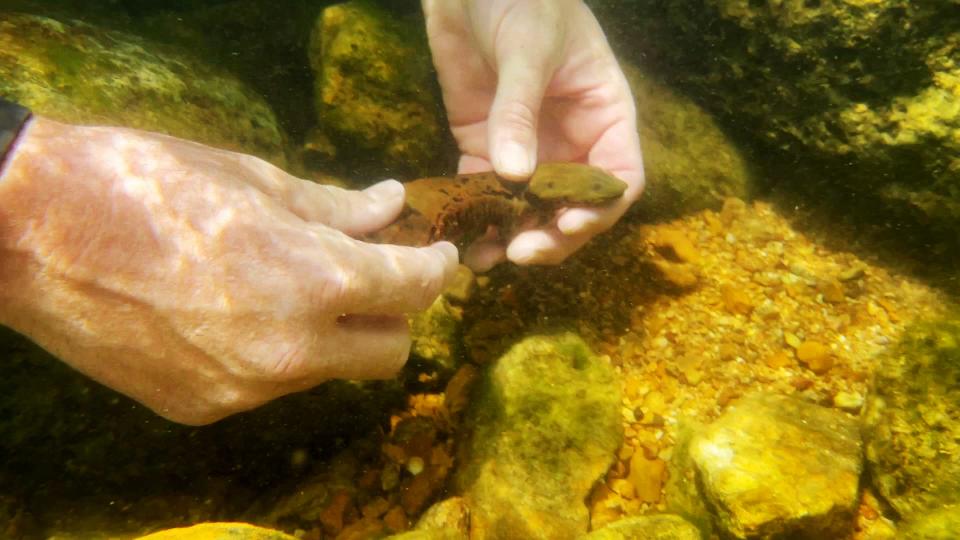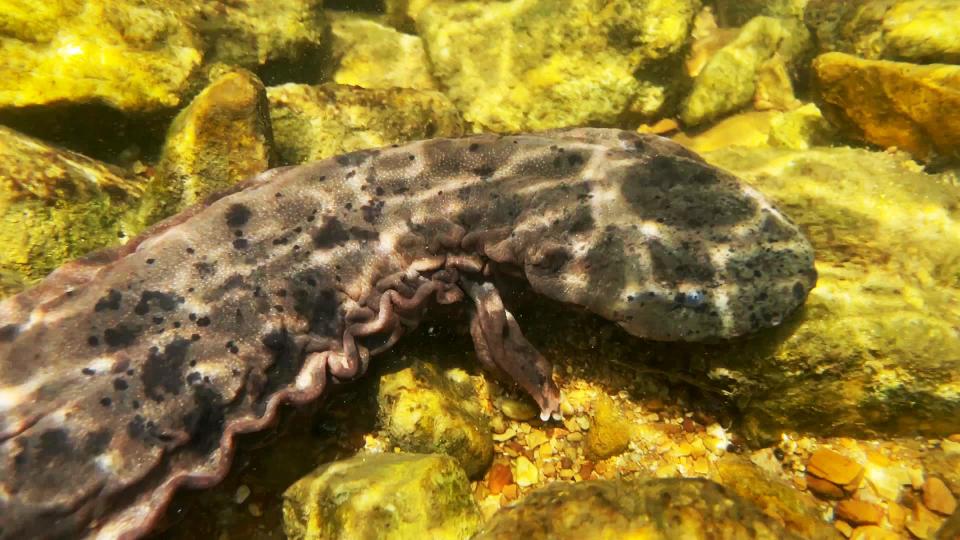Saving the hellbender: 10,000th endangered salamander released in Missouri
It's a good time for snot otters. Since conservation efforts began in 2008 to reintroduce Ozark and eastern hellbenders, 10,000 have now been released to the wild as of this month, conservation officials say.
Thousands of the endangered Ozark and eastern hellbenders have been raised at the Saint Louis Zoo and released into Missouri rivers. Three entities have been working together toward this historic milestone and they include: the Saint Louis Zoo, Missouri Department of Conservation and U.S. Fish and Wildlife Service.
"To save this species for the future to observe, we had to invest in propagation techniques," said MDC's State Herpetologist Jeff Briggler in a video with the department.
Conservationists removed hellbenders from the wild, bred them and collected eggs, Briggler added.

More: Lampreys and hellbenders and mudpuppies, oh my! Get to know Missouri’s unique creatures
"We raise them to a large enough size to help boost the population in the wild," Briggler added. "This animal has been around forever, it's been in the Ozarks for over 160 million years, so we owe it to keep it in the Ozarks."
The 10,000th hellbender was one of 235 hellbenders released into a Missouri Ozark river on Aug. 10. It was an Ozark hellbender and almost four years old.
This particular hellbender was returned to the same river where it was collected as an egg in 2018 by MDC to be hatched and raised at the zoo. River locations are not identified for animal safety reasons.
"This particular river means a lot to those of us involved in the conservation of this species, as it's the same river where the first release occurred in 2008," Briggler said in a news release from the Saint Louis Zoo.

This is the largest number of animals the Saint Louis Zoo has ever raised in human care before releasing them to the wild, said representatives from the zoo. It's also one of the largest amphibian reintroduction programs in the world.
"To date, this is the most successful hellbender release program in the country and it would not be possible without collaborative efforts between the Zoo, MDC and other partners over the last 15 years," a news release stated.
More: Saint Louis Zoo sees 'banner year' for breeding program as 1,300-plus hellbenders hatch
Briggler went on to say in the video that the salamanders are an important link in the food chain.
"They eat some of the smaller bugs in the water ― the invertebrates, the crayfish ― but, in turn, they're eaten by larger animals, such as some mammals, some birds, even large fish," Briggler said.
Hellbenders are also a good indication of environmental stress.

"If you've ever seen a hellbender, they look slimy, they absorb everything through their skin, so if there's something wrong with the river, we can tell that from that animal by removing blood or tissue," Briggler said. "But, more importantly, they are part of our biodiversity. We have 43 species of amphibians in our state, we want all 43 to be here for our future."
Come the end of summer, 811 Ozark and eastern hellbenders will have been released into Ozark rivers. Since the program started nearly 15 years ago, 10,206 Saint Louis Zoo-raised endangered hellbenders ― 9,034 Ozark hellbenders and 1,172 eastern hellbenders ― have been reintroduced to the wild in Missouri, according to the Saint Louis Zoo.
The Ozark hellbender has been found in tributaries such as Bryant Creek, the North Fork White River and Jacks Fork as well as other waterways like the Eleven Point River and the Current River.
More: Comment period for draft recovery plan for Ozark hellbenders ends with only two submitted
The need to reintroduce hellbenders stems from some potential factors affecting their environment, including:
Disease
Degraded water quality
Illegal and scientific collection
Habitat loss due to sedimentation and other components
Potentially an increase in predators from some native and non-native species of stocked fish
Sara Karnes is an Outdoors Reporter with the Springfield News-Leader. Follow along with her adventures on Twitter and Instagram @Sara_Karnes. Got a story to tell? Email her at skarnes@springfi.gannett.com.
This article originally appeared on Springfield News-Leader: Missouri releases 10,000th endangered hellbender salamander since 2008

